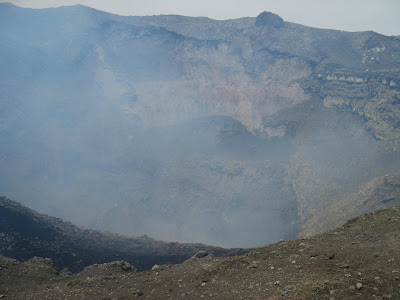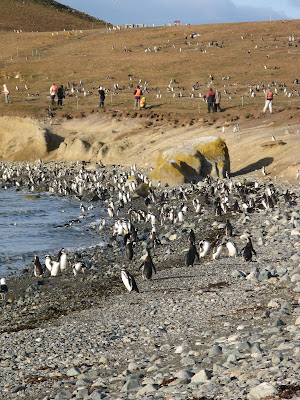22 - 23 January, Puerto Montt
Arrived in the city of Puerto Montt, disgusted at the site of first McDonalds spotted in Chile. Ordered a McChicken sandwich and Big Mac meal. Other than that, little of note. Busy port town on Pacific lacking glamor or charm, with plenty of drunken sailors peeing in doorways.
24 - 25 January, Cucao, Island of Chiloe
Chiloe Island is 55km from mainland Chile, and was strongly influenced by early Spanish settlers and Mapuche Indians. Mapuche natives are famed for strongly fought battles against Spanish colonisation. The uprising of the Mapuche around 1598 drove the Spanish south on the mainland and left the Spanish community on Chiloe isolated. The Chiloe islanders were the last supporters of the Spanish Crown in South America. When Chile rebelled, the last of the Spanish governors fled to the island and in despair, offered it to Britain. Britain declined and finally the island surrendered in 1826.

 Above: 15km of empty beach at Cucao and stilted homes in Chiloe´s capital, Castro
Above: 15km of empty beach at Cucao and stilted homes in Chiloe´s capital, CastroChiloe, Island of Gulls, is famed for its wooden architecture; churches and homes on stilts. We spent two nights on the island, with our second day on the west coast admiring the Pacific rollers and vast empty beaches. Although tourism is important for Chiloe´s economy, the island exports salmon, seaweed (muchos stink) and timber to the mainland.
 Above: Campsite view at Cucao, Chiloe. Discovered new military breed of horse fly, with armoured shell and red wing tips.
Above: Campsite view at Cucao, Chiloe. Discovered new military breed of horse fly, with armoured shell and red wing tips.25 - 26 January, Puerto Varas and Frutilla, Lago Llanquihue
From Chiloe, headed north on a lovely straight tarmac road to Lago Llanquihue. The northern lake district is by far the most popular tourist destination in Chile, and we felt a little overwhelmed to be surrounded by such an extensive, expensive tourist infrastructure.
 Went with it and booked into smart hotel over looking lake and Osorno volcano.
Went with it and booked into smart hotel over looking lake and Osorno volcano. 
Above: Kayaking on lake and view of Osorno Volcano
Ventured further north along the lake for our second evening and camped at a fantastic site in Frutilla, a stunning little town. As days of the week are of no consequence to us, it had not occurred to us that it was Friday, and the campsite soon lost its tranquility as groups of party people arrived for the weekend.
As I eventually drifted off to sleep at 1.30am, the ravers (as in dance tunes blaring) on our left, were still competing with the group singing Chilean folk songs accompanied by multiple guitars, on our right. The bar-b-q´s were still aflame. Yet again I regretted our lack of Spanish. Would have been a great place to crash a party.
27 - 28 January, Frutilla to Pucon
Travelled 300kms north to Pucon on Lago Villarrica. Pucon sits in the shadow of Villarrica Volcano. There is a clear Germanic inflence in the northern lakes. German emigration to Chile started at the time of the Crimean War, in 1855, when wealthy families emigrated to avoid enlistment in the war. Geographers and natural historians sent recommendations to Germany as they identified the northern lakes as a "place of natural, pure beauty which would allow settlers to grow and move freely." Germans brought money into the country and developed many towns between 1850´s to 1880´s.

Above: Villarrica Volcano
We cycled to waterfalls 15km from Pucon, me on a giant Niek van Bemmel size bike (6ft5 Dutch friend). The surface was a little on the rocky side and I was so glad to arrive at the falls, and spot a sign advertising fresh strudel. A near perfect tea and cake moment (sunshine, sitting alongside falls, perfect view of Osorno volcano) was ruined by the long black hair that I pulled from the middle of my chocolate banana cake. I felt exhausted, thoroughly bone-shaken and more than a little saddle sore after the 30km cycle. No worries, only climbing a 2,000 meter volcano in the morning - ahhhh.Our day started early, awaking under canvas at 5.30am. We joined our fellow hikers at the "expedition" office where two very slim, attractive, young Americans arrived in flip flops. Although the snow capped volcano can be seen from every corner of Pucon, it did not occur to them that they may require hiking boots, or that we would be hiking in snow to reach the summit. I was clearly delighted with their dimness whilst remaining extremely jealous of their bottoms. We set off to ski lifts and took a chair to the snow line of the volcano. We climbed for four hours like penguins shuffling in line, using upturned ice picks to keep us anchored to the mountain.




Above: Peering into the crater
Arrived at the summit and immediately coughed up a lung due to clouds of sulphurous smoke. A party that arrived shortly after us adorned gas masks. They must have been on a higher end tour. We peaked over the crater edge as the volcano bubbled and cracked. No danger whatsoever in this practice according to the seismic traffic light system on the tourist information office, which showed the volcano as being green light, "low risk", to those that fancied peering into the crater. Last major eruption was in 1971. I am sure my parents think of 1971 as the year of their last major disruption.

Above: We made it! Filby´s helmet was a little on the small side
I really enjoyed the upwards hike, but that was nothing compared to our descent. We pulled on big gortex nappies and slid down the mountain in snow flumes, controlling our speed with ice axes which we used as brakes. It was fantastic fun. I started very tentatively with legs out straight applying axe break for the entire flume. By the last flume, legs ups, no axe applied I piled into Filby, who had actually shot out of the flume as was in a heap. I laughed all the way down like a little kid. The American girls were terrified during the ascent, but enjoyed the flumes, with slightly more control and finesse than myself, and they were in fact very nice!

29 January - Back in Puerto Montt
Off to Santiago in the morning!











 This blog entry will be concise and visually rich. We went to sea for five days on board a most comfortable small cruiser,
This blog entry will be concise and visually rich. We went to sea for five days on board a most comfortable small cruiser, 










 Above: Day four - thigh-deep muddy walk through forest to
Above: Day four - thigh-deep muddy walk through forest to 
 Above: Day five - Stunning
Above: Day five - Stunning 
 Most pleasant company and always appreciates a good meal and a few
Most pleasant company and always appreciates a good meal and a few 


 We have taken in the maritime museum, the old prison museum, the double decker city bus tour (takes an hour and that is dragging it out) and we visited Tierra Del Fuego National Park. Trekking concluded in a visit to a beaver colony. Most impressed by the sheer scale of the beaver dams. Didn't see any beavers though which was a shame and surprising as there are over 100,000 beavers in Tierra Del Fuego. Introduced (of course) by early European settlers, the beaver fur business didn't succeed, but the beavers continue to happily breed and munch their way through vast areas of native beech tree forest.
We have taken in the maritime museum, the old prison museum, the double decker city bus tour (takes an hour and that is dragging it out) and we visited Tierra Del Fuego National Park. Trekking concluded in a visit to a beaver colony. Most impressed by the sheer scale of the beaver dams. Didn't see any beavers though which was a shame and surprising as there are over 100,000 beavers in Tierra Del Fuego. Introduced (of course) by early European settlers, the beaver fur business didn't succeed, but the beavers continue to happily breed and munch their way through vast areas of native beech tree forest. 







